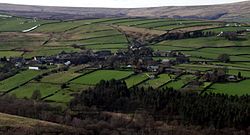Holme, West Yorkshire
| Holme | |
|---|---|
 Holme, viewed from Ramsden Road |
|
| Holme shown within West Yorkshire | |
| Metropolitan borough | |
| Metropolitan county | |
| Region | |
| Country | England |
| Sovereign state | United Kingdom |
| Post town | Holmfirth |
| Postcode district | HD9 |
| Dialling code | 01484 |
| Police | West Yorkshire |
| Fire | West Yorkshire |
| Ambulance | Yorkshire |
| EU Parliament | Yorkshire and the Humber |
| UK Parliament | |
Holme is a small rural village 2.5 miles (4 km) southwest of the town of Holmfirth and 9.7 miles (16 km) from Tintwistle on the edge of the Pennines in England. Between Holmbridge and Lane Village in West Yorkshire close to the border with Derbyshire. It lies on the boundary of the Peak District National Park, with some properties split to lie partially outside of it.
Near the village is the Holme Moss radio transmitter that is 526 metres (1,726 ft) above sea level and 200 metres (660 ft) tall. The Pennine Way passes Southwest of the transmitter over Black Hill.
The water seeping from the surrounding moorland is the source of the River Holme, which passes down through the Holme Valley to Huddersfield, where it flows into the river Colne. It is accessed by the A6024 Woodhead Road.
The village contains a pub, called the Fleece, and a school.
On 6 July 2014, Stage 2 of the 2014 Tour de France from York to Sheffield, passed through the village.
The schoolroom was originally built in 1694 with the interest earned from money bequeathed by Joshua Earnshaw (£300) in 1693 and on land given by James Earnshaw, which is recorded in a document entitled: Township of Holme – Earnshaw's Charity. Having become dilapidated, it was rebuilt in 1820 and again in 1838 when a schoolmaster's house was added at a cost of £680. The schoolroom of this charity was closed in 1880 when education was conducted in other premises of the school board.
The schoolmaster was paid from the interest accrued annually on the £300 placed in the charity. The number of children varied from 30 to 40. Until the date of the Elementary Education Act 1891, the school fees of certain children attending the Board School in Holme were paid, but this was discontinued when education was made free, and the school governors then devoted the money to the formation of a school library, with annual payments for books made from the charity.
...
Wikipedia

